Related Research Articles

Rodeo is a competitive equestrian sport that arose out of the working practices of cattle herding in Spain and Mexico, expanding throughout the Americas and to other nations. It was originally based on the skills required of the working vaqueros and later, cowboys, in what today is the western United States, western Canada, and northern Mexico. Today, it is a sporting event that involves horses and other livestock, designed to test the skill and speed of the cowboys and cowgirls. American-style professional rodeos generally comprise the following events: tie-down roping, team roping, steer wrestling, breakaway roping, saddle bronc riding, bareback bronc riding, bull riding and barrel racing. The events are divided into two basic categories: the timed events and the roughstock events. Depending on sanctioning organization and region, other events such as steer roping, goat tying, and pole bending may also be a part of some rodeos. The "world's first public cowboy contest" was held on July 4, 1883, in Pecos, Texas, between cattle driver Trav Windham and roper Morg Livingston.

Bronc riding, either bareback bronc or saddle bronc competition, is a rodeo event that involves a rodeo participant riding a bucking horse that attempts to throw or buck off the rider. Originally based on the necessary buck breaking skills of a working cowboy, the event is now a highly stylized competition that utilizes horses that often are specially bred for strength, agility, and bucking ability. It is recognized by the main rodeo organizations such as the Professional Rodeo Cowboys Association (PRCA) and the International Professional Rodeo Association (IPRA).

Bodacious #J-31 was an American bucking bull. He was known throughout the rodeo world as "the world's most dangerous bull". He was also known as "the greatest bull ever to buck". During his rodeo career, he was the 1994 and 1995 Professional Rodeo Cowboy Association (PRCA) Bucking Bull of the Year, as well as the 1995 Professional Bull Riders (PBR) World Champion Bull. He and Bruiser are the only bulls who have won bucking bull world championship titles in both organizations.
The National Finals Rodeo (NFR) is the premier championship rodeo of the Professional Rodeo Cowboys Association (PRCA). It showcases the talents of the PRCA's top 15 money winners in the season for each event.
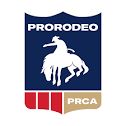
The Professional Rodeo Cowboys Association (PRCA) is the largest rodeo organization in the world. It sanctions events in the United States, Canada, and Mexico, with members from said countries, as well as others. Its championship event is the National Finals Rodeo (NFR). The PRCA is headquartered in Colorado Springs, Colorado, United States.
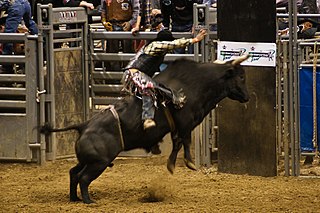
The ProRodeo Hall of Fame and Museum of the American Cowboy was opened in August 1979 as a museum designed to "preserve the legacy of the cowboy contests, the heritage and culture of those original competitions, and the champions of the past, present and future." It is located in Colorado Springs, Colorado, and only inducts Professional Rodeo Cowboys Association and Women's Professional Rodeo Association members. It is the "only museum in the world devoted exclusively to the sport of professional rodeo."

Cowboy culture is the set of behaviors, preferences, and appearances associated with the attitudes, ethics, and history of the American cowboy. The term can describe the content or stylistic appearance of an artistic representation, often built on romanticized impressions of the wild west, or certain aspects of people's lifestyle, such as their choices in recreation, apparel, and western or southwestern cuisine.

Bucking is a movement performed by an animal in which it lowers its head and raises its hindquarters into the air while kicking out with the hind legs. It is most commonly seen in herbivores such as equines, cattle, deer, goats, and sheep. Most research on this behavior has been directed towards horses and cattle.

A mechanical bull, also known as a bucking machine, is a device that replicates the sensation of riding a bucking animal, such as a rodeo bull or horse, popularized by Sherwood Cryer. It is usually powered by a variable-speed electric motor. Padded flooring is often installed around the equipment in order to reduce the likelihood of injury to those thrown off it.
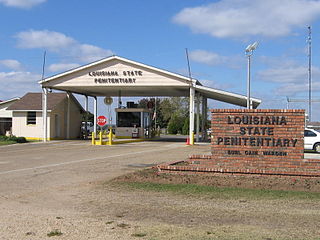
The Angola Prison Rodeo, staged at the Louisiana State Penitentiary, is the longest running prison rodeo in the United States.

A stock contractor is an individual or business that provides animals for rodeo competition. Stock contractors supply rough stock - bucking horses for saddle bronc and bareback bronc riding and bucking bulls for bull riding, plus steers for steer wrestling and team roping, plus calves for calf roping and breakaway roping events. The use of stock contractors who specialize in providing these animals has produced a more uniform range of bucking stock which is also quieter to handle.
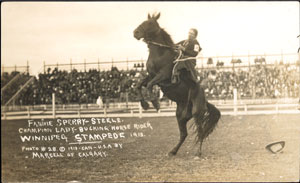
Fannie Sperry Steele, born Fannie Sperry, was an American bronc rider and rodeo performer from Montana. She was one of the first women inducted into the Rodeo Hall of Fame of the National Cowboy and Western Heritage Museum in 1975, and the first Montana native in the National Cowgirl Hall of Fame in 1978.
The Heart of the North Rodeo is located in Spooner, Wisconsin, United States. The rodeo takes place the first full weekend in July every year since 1954, except 2020. It is sanctioned by the Professional Rodeo Cowboys Association (PRCA). Fans from all over come to watch the professional cowboys and cowgirls compete in the seven main events of rodeo, and even some up-and-coming little cowboys and cowgirls.

A bucking bull is a bull used in rodeo bull riding competition. They are usually a Brahman crossed with another breed, weighing 1,500 pounds or more, selected for their tendency to "leap, plunge and spin" when a human is on its back. Circa mid-20th century breeders began selecting bulls for bad temperament, that would buck when ridden. Many of the best bucking bulls trace their lineage to bulls owned by Charlie Plummer of Oklahoma. These are known as Plummer bulls.
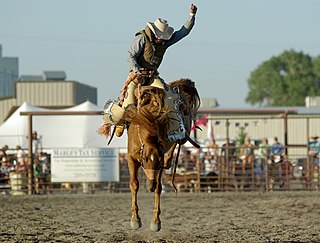
A bucking horse is any breed of horse, male or female, with a propensity to buck. They have been, and still are, referred to by various names, including bronco, broncho, and roughstock.

Tornado was an American bucking bull. He went to the National Finals Rodeo (NFR) at least four times. He was voted Bucking Bull of the NFR four times consecutively from 1962 to 1965. Owned by rodeo champion Jim Shoulders, Tornado was named the "meanest bull alive" at the NFR four times. Tornado is best known for his matchup with ProRodeo Hall of Fame bull rider, Freckles Brown, which is most often referred to as "The Ride." It was Brown who, in 1967, broke Tornado's undefeated streak of 220 buckoffs in six years. Tornado, Brown, and Shoulders all have been recorded in The Encyclopedia of Oklahoma History and Culture maintained online by the Oklahoma Historical Society. Tornado was inducted into the ProRodeo Hall of Fame 1979 and the Bull Riding Hall of Fame in 2016.
Miniature bull riding is a rodeo sport that involves a youth rider getting on a miniature bull and attempting to stay mounted while the animal attempts to buck off the rider. It is bull riding on a smaller scale, as both the bull and the rider are smaller than in professional rodeo. All competitors are under age 18.
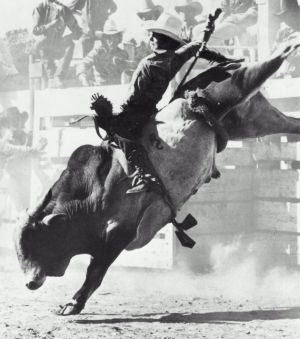
Oscar #16 was a ProRodeo Hall of Fame bucking bull. The hall of fame inducted Oscar in its 1979 inaugural class of inductees. To date, only seven bulls have been inducted, which is the highest honor a bucking bull can receive in the Professional Rodeo Cowboys Association (PRCA). The California Rodeo Salinas inducted Oscar into its hall of fame in 2013. In 2018, the Bull Riding Hall of Fame inducted Oscar. In over 300 attempts, only eight bull riders made qualified rides of the requisite eight seconds on Oscar. Eight-time world champion bull rider Don Gay made the highest-scored ride on him at the time, earning 97 points, just 3 points short of a perfect score. Oscar's owners retired him in 1979 as a living exhibit to the ProRodeo Hall of Fame in Colorado Springs, Colorado. He remained at the hall until his death in 1983.

American Bucking Bull, Inc. (ABBI) is an organization dedicated to the registration of bucking bulls and establishing the American Bucking Bull as a documented breed of cattle. American Bucking Bull, Inc., is owned by the Professional Bull Riders (PBR) and stock contractors. The organization created a breed registry and manages the registration and certification of American Bucking Bulls. It also keeps records of other breeds of bulls, some of which died out many years ago. It is the largest organization performing these functions. It maintains a genetic DNA database, manages bucking bull pedigrees and encourages the growth of the breed. ABBI also holds competitions for bucking bulls ages two through four. It also has its own magazine, the American Bucking Bull.
Bobby Brooks Kramer, was a hall of fame equestrian and rodeo performer. She was one of the earliest bronc riders who competed for money. She had a successful rodeo career. After that, she and her husband formed the Diamond A Horse Ranch. She won many awards and trophies in cutting, trail, reining, and pleasure riding. She was inducted into the National Cowgirl Museum and Hall of Fame in 2000.
References
- ↑ "Miles City Bucking Horse Sale". Archived from the original on April 29, 2014. Retrieved February 1, 2018.
- ↑ "31 Miles City Bucking Horse Sale". YouTube. 12 November 2011. Archived from the original on 2021-12-21. Retrieved February 1, 2018.
- ↑ Keeler, Greg. "Songs of Fishing, Sheep, and Guns in Montana". The Miles City Buckin' Horse Sale. www.troutball.com. Archived from the original on June 30, 2013. Retrieved February 1, 2018.
- ↑ "The Miles City Buckin' Horse Sale". Troutball. July 3, 2011. Archived from the original on June 30, 2013. Retrieved July 3, 2011.
- ↑ "Rain wipes out Miles City racing". Billings Gazette. May 20, 2011. Retrieved June 26, 2011.
- "Bareback riders showcase the best bucking broncos". CBS Sunday Morning. Archived from the original on 2011-07-04. Retrieved July 3, 2011.